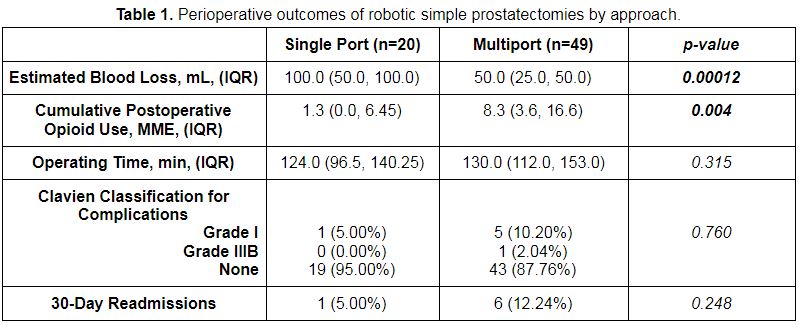Back
Poster, Podium & Video Sessions
Moderated Poster
MP29: Benign Prostatic Hyperplasia: Surgical Therapy & New Technology III
MP29-15: Comparison of Perioperative Outcomes between Transvesical Single Port and Intravesical Multiport Robotic Assisted Simple Prostatectomy: A Single Center Study
Saturday, May 14, 2022
1:00 PM – 2:15 PM
Location: Room 225
Bilal Ahmed Khan, Hackensack, NJ, Tanner Corse, Jay Zaifman, Nutley, NJ, Ruth Sanchez De La Rosa, Sarah Brink*, Janmejay Hingu, Suzannah Sorin, Hackensack, NJ, Ravi Munver, Michael Stifelman, Mutahar Ahmed, Nutley, NJ
.jpg)
Sarah Brink, MD
PGY2 Urology
Poster Presenter(s)
Introduction: The Single Port (SP) robotic approach is a new technology that can be utilized in the surgical treatment of benign prostatic hyperplasia (BPH). While studies have compared the outcomes of robotic versus open approach, this is the first study to compare perioperative outcomes of the transvesical SP to the intravesical multiport (MP) robotic approach for simple prostatectomy.
Methods: This is a retrospective, single-center study involving 69 patients who underwent SP or MP simple prostatectomy for BPH between 2019 and 2021. Demographic, intraoperative, and postoperative data were collected and compared. Opioid use was reported in Morphine Milligrams Equivalents (MME). Continuous data was analyzed using the Wilcoxon Rank Sum test. Categorical data was analyzed using Chi-Squared and Fisher's Exact Tests where appropriate.
Results: Of the 69 patients included, 20 (28.99%) underwent a transvesical SP and 49 (71.01%) underwent an intravesical MP approach through the posterior aspect of the bladder. There were no significant differences between age, body mass index (BMI), ethnicity, and comorbidities between the two groups. The SP approach was used on significantly smaller median prostate sizes in comparison to the MP approach (83.50 g vs 150.0 g, p=0.00009). The SP approach demonstrated significantly lower estimated blood loss (50.0 vs 100.0, p=0.0001) and lower postoperative opioid use (1.3 MME vs 8.3 MME, p=0.004). There were no significant differences between groups in regards to operating times and peri-operative complications.
Conclusions: This study represents the first comparison between SP and MP approaches for simple prostatectomy. SP simple prostatectomy demonstrated decreased estimated blood loss and postoperative opioid requirements with similar operating time and rate of complications when compared to the MP approach. Further research into the long term efficacy and safety of the SP approach are needed for this indication.
Source of Funding: None

Methods: This is a retrospective, single-center study involving 69 patients who underwent SP or MP simple prostatectomy for BPH between 2019 and 2021. Demographic, intraoperative, and postoperative data were collected and compared. Opioid use was reported in Morphine Milligrams Equivalents (MME). Continuous data was analyzed using the Wilcoxon Rank Sum test. Categorical data was analyzed using Chi-Squared and Fisher's Exact Tests where appropriate.
Results: Of the 69 patients included, 20 (28.99%) underwent a transvesical SP and 49 (71.01%) underwent an intravesical MP approach through the posterior aspect of the bladder. There were no significant differences between age, body mass index (BMI), ethnicity, and comorbidities between the two groups. The SP approach was used on significantly smaller median prostate sizes in comparison to the MP approach (83.50 g vs 150.0 g, p=0.00009). The SP approach demonstrated significantly lower estimated blood loss (50.0 vs 100.0, p=0.0001) and lower postoperative opioid use (1.3 MME vs 8.3 MME, p=0.004). There were no significant differences between groups in regards to operating times and peri-operative complications.
Conclusions: This study represents the first comparison between SP and MP approaches for simple prostatectomy. SP simple prostatectomy demonstrated decreased estimated blood loss and postoperative opioid requirements with similar operating time and rate of complications when compared to the MP approach. Further research into the long term efficacy and safety of the SP approach are needed for this indication.
Source of Funding: None

.jpg)
.jpg)